In our latest Library feature, Katelyn Rushe shares her theory that Smaug doesn’t speak English, Bilbo gains the ability to speak and understand Dragon when he puts on the One Ring.
How Do You Talk to a Dragon?
by: Katelyn Rushe
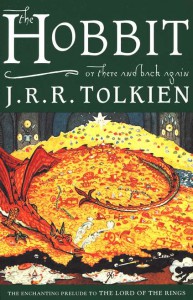 By far one of the most iconic figures from any work of J.R.R. Tolkien’s is Smaug from 1937’s The Hobbit. While not the first treasure-obsessed dragon to terrorize villagers in the history of literature, Smaug is one of the most memorable and widely portrayed. This is possibly because he was one of the first and still one of the few who speaks.
By far one of the most iconic figures from any work of J.R.R. Tolkien’s is Smaug from 1937’s The Hobbit. While not the first treasure-obsessed dragon to terrorize villagers in the history of literature, Smaug is one of the most memorable and widely portrayed. This is possibly because he was one of the first and still one of the few who speaks.
Dragons in fantasy traditionally don’t serve as characters, but rather as plot devices; they are obstacles without personalities or voices that are in the story for no other reason than to be vanquished by the heroes. Tolkien’s fiery villain, in contrast, is a character with a cunning and cocky personality that he frequently makes known to Bilbo Baggins and the readers by boasting of his abilities in words.
With that said, here’s my latest fan theory that I want to put to the test: that the Smaug played by Benedict Cumberbatch in the Peter Jackson Hobbit film trilogy does not in fact speak English.
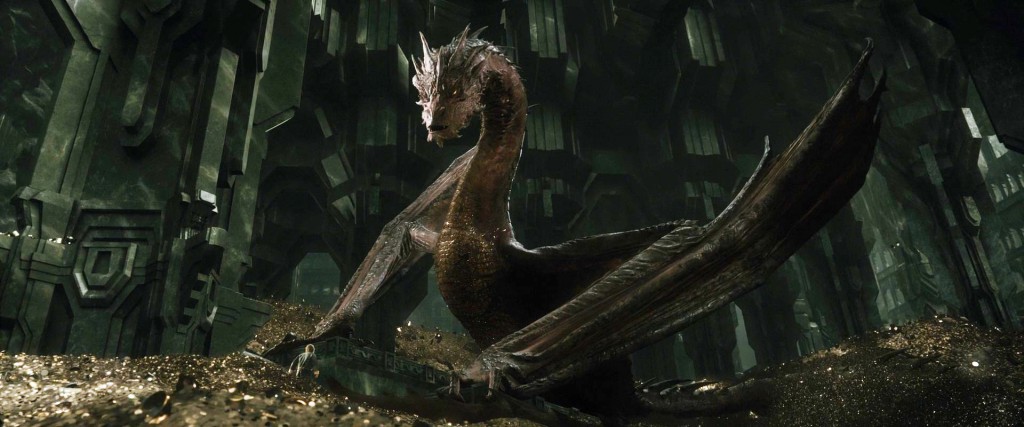
One of the films’ more clever changes to the story of The Hobbit is the One Ring’s power to make its bearer understand the language of magical creatures while wearing it. We see this occur once in the second film, when Bilbo rescues his companions from a nest of giant spiders. This concept was obviously created as a means of being true to the source material, where Bilbo hears the spiders talking, while also keeping with the screen adaptation’s more realistic approach of not having any of the animals actually talk. What’s interesting about it though is that we clearly hear one of the spiders say something in English to Bilbo after he takes off the Ring. Some viewers may see this as a continuity error, but others see it as Bilbo retaining his ability to understand the creature’s words once the Ring grants him with that power.
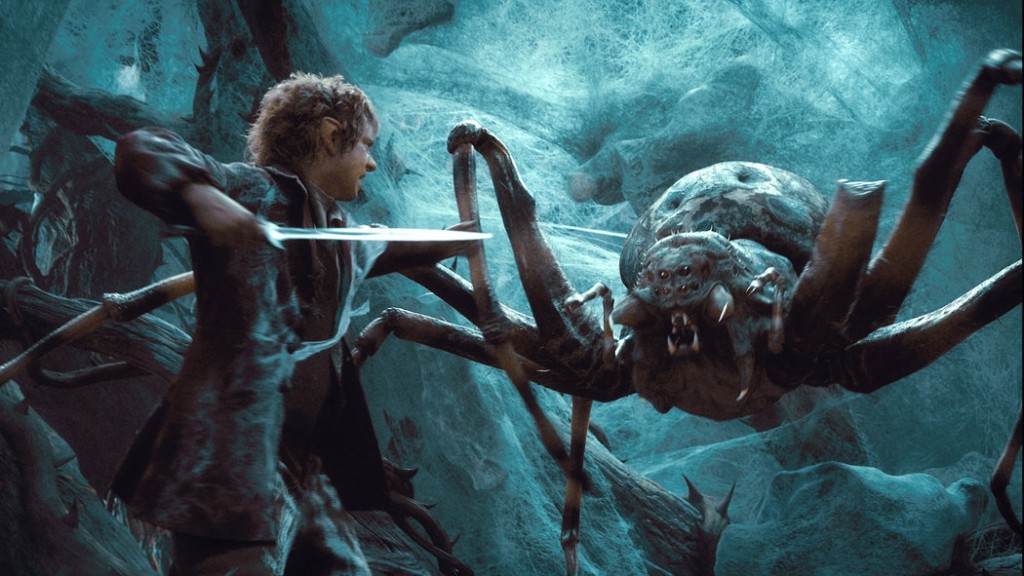 It’s possible then that the same thing occurs during his meeting with Smaug later in the film. Bilbo initially puts on the One Ring to conceal himself from the dragon, then he reluctantly takes it off when its power becomes too overwhelming. From there, the hobbit and Smaug share two conversations until the latter exits the Lonely Mountain to attack Lake-town. One wonders if either conversation would have taken place if Bilbo had kept the Ring in his pocket the entire time that he was in the mountain.
It’s possible then that the same thing occurs during his meeting with Smaug later in the film. Bilbo initially puts on the One Ring to conceal himself from the dragon, then he reluctantly takes it off when its power becomes too overwhelming. From there, the hobbit and Smaug share two conversations until the latter exits the Lonely Mountain to attack Lake-town. One wonders if either conversation would have taken place if Bilbo had kept the Ring in his pocket the entire time that he was in the mountain.
 This theory gains a bit more weight when looking at Smaug’s scenes without the burglar. We see the dragon assault the city of Dale and take over the Lonely Mountain in the opening of the trilogy’s first film, but not once does he ever say anything during that massacre. The argument can be made that he’s too preoccupied with his task to comment on it, as it’s probably difficult to speak while breathing fire, and the filmmakers are clearly trying to keep him under wraps until Bilbo meets him, though from what we learn about him in the next film, it seems odd that he would do something so catastrophic without bragging about it to the people he’s killing.
This theory gains a bit more weight when looking at Smaug’s scenes without the burglar. We see the dragon assault the city of Dale and take over the Lonely Mountain in the opening of the trilogy’s first film, but not once does he ever say anything during that massacre. The argument can be made that he’s too preoccupied with his task to comment on it, as it’s probably difficult to speak while breathing fire, and the filmmakers are clearly trying to keep him under wraps until Bilbo meets him, though from what we learn about him in the next film, it seems odd that he would do something so catastrophic without bragging about it to the people he’s killing.
Smaug doesn’t say very much when the dwarves are trying to apprehend him in the second film either. The only times he ever seems to address anyone in those scenes is when Bilbo is present. He says a great deal to Bard the Bowman while attacking Lake-town, which Mr. Baggins is not present during, but upon closer inspection, that exchange doesn’t seem quite as interactive as the ones with the hobbit.
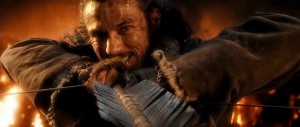 Bard never speaks to Smaug. He just goes about his business of preparing to fire his black arrow while the dragon taunts him. Again, it’s possible that the man is too preoccupied with what he’s doing to say anything (and really, what can anyone say to a dragon who just burned down their entire town?), but the notion that the audience is being allowed to hear something that he can’t in that scene holds up fairly well. Bard’s supposed reactions to some of the things that Smaug says could be seen as Smaug commenting on things as Bard is realizing them for himself.
Bard never speaks to Smaug. He just goes about his business of preparing to fire his black arrow while the dragon taunts him. Again, it’s possible that the man is too preoccupied with what he’s doing to say anything (and really, what can anyone say to a dragon who just burned down their entire town?), but the notion that the audience is being allowed to hear something that he can’t in that scene holds up fairly well. Bard’s supposed reactions to some of the things that Smaug says could be seen as Smaug commenting on things as Bard is realizing them for himself.
For instance, the bowman looks at his son Bain after the dragon makes a comment about the boy; Smaug’s glare at Bain while making that comment would be enough indication that he’s taking note of the youngster and would give Bard enough reason to look at his son with concern. Also, Cumberbatch’s Smaug certainly seems like the type who would gloat at someone even when he knows they can’t understand him.
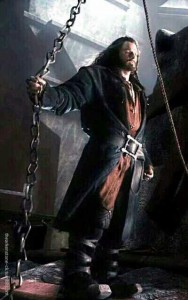 The only other person that the dragon speaks to, just before flying to Lake-town, is Thorin Oakenshield. The following lines are said:
The only other person that the dragon speaks to, just before flying to Lake-town, is Thorin Oakenshield. The following lines are said:
THORIN: Here, you witless worm!
SMAUG: You.
THORIN: I have taken back what you stole.
SMAUG: You will take nothing from me, dwarf. I laid low your warriors of old. I instilled terror in the hearts of men. I am King Under the Mountain.
THORIN: This is not your kingdom. These are dwarf lands, this is dwarf gold, and we will have our revenge.
SMAUG: Revenge? I will show you revenge!
This could almost read as Thorin giving a separate speech to Smaug that just happens to be about the same thing as the dragon’s speech to him, unbeknownst to the dwarf king. It would make sense for both characters to have similar mindsets like this since they’ve spent the past several minutes fighting each other for the mountain, and since Smaug’s ability to understand English is not being questioned, it makes sense for him to give the appropriate reactions and responses to what Thorin says. However, Thorin’s reply to Smaug calling himself King Under the Mountain can read as a comprehending dialogue between the two and is probably the strongest argument against the “Smaug doesn’t speak English” theory.
To still humor that idea though, this scene could perhaps be interpreted not as the dragon speaking English to Thorin, but as Thorin also having the ability to understand dragon speech.
Just look at the third Hobbit film. When it becomes clear to Thorin that he and his company will have to defend the Lonely Mountain from the Lake-town survivors and the Mirkwood elves, he sends a raven to his cousin Dain to call for reinforcements. The raven isn’t carrying any letters when it leaves the mountain, and since the dwarves are able to communicate with the ravens in the book, it has to be assumed that Thorin verbally gave the bird his message to deliver and Dain was able to understand the animal in order to receive that message.
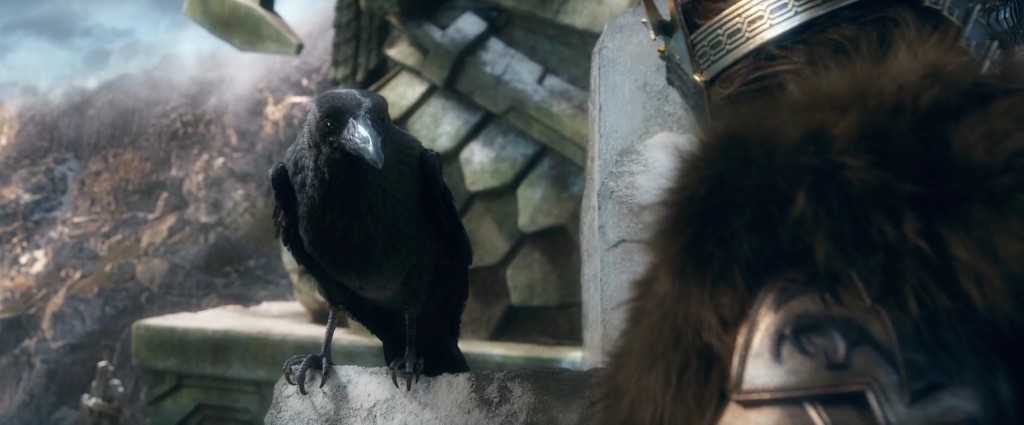 If the film dwarves are able to converse with one creature, then they may be able to converse with others. And who knows? It’s possible that Thorin’s susceptibility to dragon sickness could have given him the ability to understand Smaug, similar to how the One Ring may have given it to Bilbo. Durin’s line is said to be more susceptible to dragon sickness than other dwarves are, and since none of the other members of Thorin’s company attempt to speak with Smaug during their confrontation, it could be common knowledge among them that only their leader has the skill to do so. They may not know that dragon sickness is the cause of it, though.
If the film dwarves are able to converse with one creature, then they may be able to converse with others. And who knows? It’s possible that Thorin’s susceptibility to dragon sickness could have given him the ability to understand Smaug, similar to how the One Ring may have given it to Bilbo. Durin’s line is said to be more susceptible to dragon sickness than other dwarves are, and since none of the other members of Thorin’s company attempt to speak with Smaug during their confrontation, it could be common knowledge among them that only their leader has the skill to do so. They may not know that dragon sickness is the cause of it, though.
By either of these rationals, Bard remains the one character out of the three addressed by Smaug who can’t decipher the villain’s words; the plot point of him learning of Smaug’s weak spot from the thrush is written out of the films, implying that this version of Bard can’t communicate with other species, and he of course is never corrupted by dragon sickness.
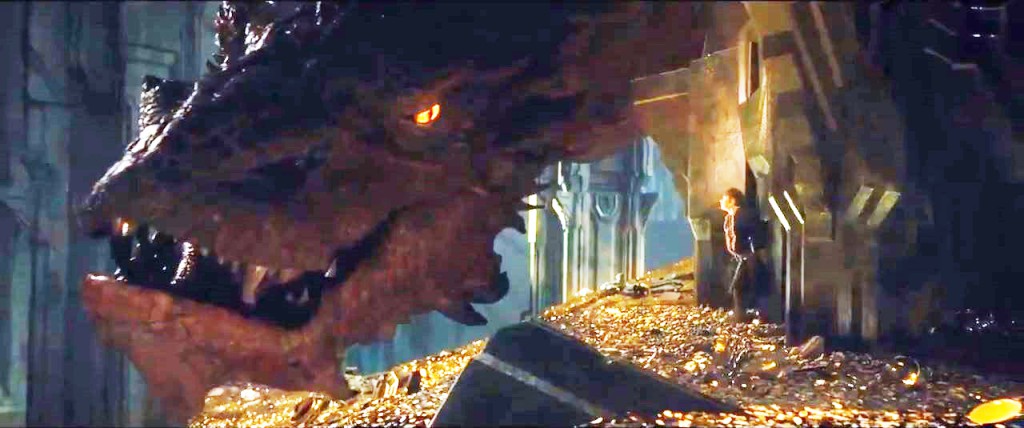 Whatever language Smaug does speak, he remains one of epic fantasy’s most outspoken dragons. He rightfully deserves his distinction as one of the most famous (or infamous) as well, and Cumberbatch’s eerily arrogant portrayal of him in the Hobbit film trilogy will no doubt be the most prevalent one in people’s minds for many years to come. If the above theory has intrigued anybody, then perhaps the regard of that portrayal will be just a little more open to interpretation — so to speak.
Whatever language Smaug does speak, he remains one of epic fantasy’s most outspoken dragons. He rightfully deserves his distinction as one of the most famous (or infamous) as well, and Cumberbatch’s eerily arrogant portrayal of him in the Hobbit film trilogy will no doubt be the most prevalent one in people’s minds for many years to come. If the above theory has intrigued anybody, then perhaps the regard of that portrayal will be just a little more open to interpretation — so to speak.
~~ * ~~
Katelyn Rushe is an independent author, illustrator, and filmmaker from Pennsylvania. A lifelong Tolkien fan, she is currently editing the first book in her own science fiction/fantasy series, which is due to be released later this year. Her current works are available on Amazon and Kindle, and her blog “What’s New With K. Ru.” can be found on www.blogger.com: http://whatsnewwithkru.blogspot.com/


